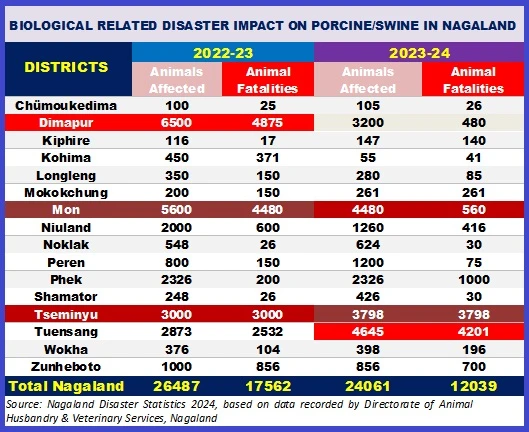Source: Nagaland Disaster Statistics 2024, based on data recorded by Directorate of Animal Husbandry & Veterinary Services.

Over 31,700 livestock lost in two years; poultry and swine most affected
Moa Jamir
Dimapur | June 2
The severe impact of recurring animal disease outbreaks such as bird flu and African Swine Fever (ASF) along with the persistent threat posed by animal-borne diseases to livestock is starkly reflected in the Nagaland Disaster Statistics 2024.
According to the annual report published by the Directorate of Economics & Statistics, these disease outbreaks, classified as biological-related disasters, collectively claimed the lives of 31,771 animals across the State in 2022–23 and 2023–24.
Poultry losses
In 2022–23, the state recorded 79 incidents of biological disease outbreaks affecting 47,500 poultry birds, resulting in the death of 19,013.
While the number of reported incidents slightly increased to 80 in 2023–24, the impact on poultry was marginally lower, affecting 45,196 birds and causing 17,873 deaths.
District-wise in 2023-24, Tuensang reported the highest number of poultry affected (11,606), followed by Zunheboto (10,384) and Longleng (7,300).
In terms of fatalities, Zunheboto topped the list with 6598 deaths, followed by Longleng (3,180) and Niuland (1880).
In 2022–23, Longleng was the worst-affected district with 13,200 cases and 6000 deaths. Tuensang followed with 8548 cases and 1514 deaths, while Niuland reported 6800 cases and 4760 deaths.
Across both years, around 40% of the affected poultry livestock succumbed to disease, indicated analysis of the data.

Heaviest toll among other animals
Besides poultry, other animals primarily swine, along with cattle, goats, and pets were also severely impacted.
In 2022–23, 232 incidents were reported involving 31,325 animals, leading to 18,543 deaths.
The number of incidents rose to 249 in 2023-24 but number of affected animals decreased to 28,357 with 13,898 deaths reported.
This translated to a mortality rate of approximately 59.2% in 2022–23 and 49% in 2023–24.
However, data showed that swine, the most preferred source of protein in Nagaland, bore the brunt of the impact.
In 2023–24, out of 28,357 animals affected by disease outbreaks, 24,061 (84.85%) were swine. Similarly, pigs accounted for 12,039 of the 13,898 reported animal deaths—an overwhelming 86.63% of the total fatalities.
Likewise, in 2022–23, pigs made up over 84% (26,487) of the 31,325 affected animals. They also represented more than 94% (17,562) of the total 18,543 animal deaths recorded that year.
In 2023–24, Tuensang district reported the highest number of pigs affected (4645), with 4201 fatalities. Mon district followed with 4480 cases and Dimapur with 3200.
Alarmingly, all 3798 pigs reported affected in Tseminyu were recorded as deaths, along with all 261 in Mokokchung.
A similar trend was observed in 2022–23, where Tseminyu again reported all 3000 affected pigs as deaths. Dimapur had the highest infection at 6500 as well as death toll at 4875, followed by Mon where 5600 swine were affected, resulting in 4,480 deaths.
In 2023-24, the second highest affection was bovine animals at 2389 with 567 deaths.
Incidentally, the report had data on the impact on pet animals for only seven districts—Kiphire, Phek, Shamator, Tuensang, Wokha, and Zunheboto.
In 2023-24, a total of 1995 pet animals were affected, leading to 535 fatalities.
The total number affected decreased to 1676 in 2023-24, but mortalities more than doubled to 1190.
However, there seem to be some anomalies, with Wokha showing more deaths (770) than those affected and the number curiously matching the exact 2023-24 figure of 314.
Vector-borne diseases and crop pest
Meanwhile, the report highlighted a surge in vector-borne diseases. Dimapur district experienced a dengue epidemic in 2023, with cases rising sharply to 2001 from just 142 in 2022. Overall, vector-borne cases increased to 2129 in 2023, compared to 157 the previous year.
However, only 15 cases of Japanese Encephalitis (JE) and 6 malaria cases were reported over the two years. Notably, just one malaria case was recorded in 2023.
Crop damage due to pest attacks also saw an increase. In 2023–24, horticultural crops across 61 acres were affected, up from 59.3 acres the previous year.
Pest infestation on agricultural land rose to 657.45 hectares, with Mokokchung and Peren districts being the worst-affected.
Biological-related disasters
As per the report, biological-related disasters refer to “catastrophic events that arise from or are associated with the spread of infectious diseases or outbreaks of illnesses that affect humans, animals or plants.”
These events can significantly impact the environment, public health, and the socio-economic well-being of communities.
Under the Disaster Management Act, 2005, these are classified into biological disasters and epidemics; pest attacks; cattle epidemics; and food poisoning.
Biological-related disasters emerged as the most common type in Nagaland, accounting for 2338 incidents in 2022–23 and 1955 in 2023–24.
This represents approximately 44% of all disaster events recorded during the two years, the report noted.
Water- and climate-related disasters were the second most prevalent, constituting over 35% of total disaster incidents.
In total, Nagaland reported 5091 disaster events in 2022–23 and 4584 in 2023–24.






